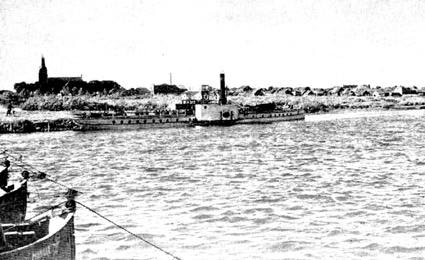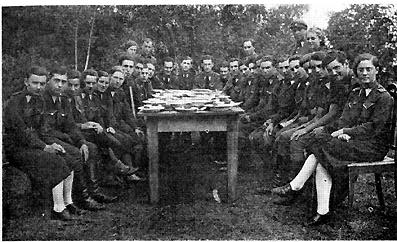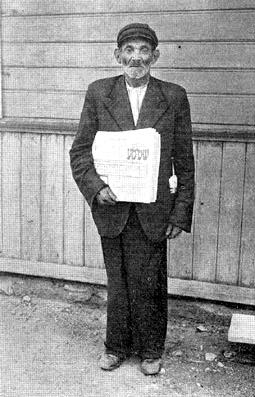
Yurburg is situated on the right hand shore of the Nieman (Nemunas) river where the tributaries Mituva and Imstra converge. The town used to be about 12 km (7.5 miles)to the east of the Prussian border, surrounded by woods. It began as a stronghold of the Knights Order of the Cross in the 13th century named Georgenburg or Jurgenburg, but after the border between Lithuania and Germany was defined in 1422, Yurburg became a border town and a customs point. During the 13th century the importance of Yurburg increased due to the harvesting of trees in the surrounding woods for commercial purposes, when the logs were floated on the Nieman river to Prussia. Thanks to the ethnic diversity of its inhabitants, its location on a main sailing route - the Nieman - and its proximity to Prussia, Yurburg became a communication and commercial center between east and west. During Russian rule (1795-1915) the town was included in the Kovno Gubernia (province).
As a result of railway construction and road improvement in the region during the 19th century, sailing on the Nieman subsided and the growth of Yurburg slowed down. The town was taken over by rebels for a short time during the Polish mutiny in 1831, but after the mutiny was repressed by the Tzar, Yurburg returned to its former life.
German culture from across the border influenced the social life greatly and affected the mode of living in town, which also continued to be the case during the period of Lithuania’s independence (1918-1940).
Because of its topographic situation and location between the two rivers and the Nieman, the town frequently suffered from floods. In 1862 eighty houses were inundated and their residents rescued themselves by climbing onto the roofs.Yurburg also suffered from fires, the greatest fires being in 1906 when 120 of its houses burnt down.
Yurburg was first mentioned in the book of Rabbi Meir ben Gedalyah (1558-1616) from Lublin "Sheloth uTeshuvoth" (Questions and Answers) concerning the case of an "Agunah" (deserted wife) whose husband had been killed in Yurburg. The testimonies of this case were reported in 1593 and 1597. During the period of the autonomous organization of Jewish communities in Lithuania "Va'ad Medinath Lita" (1623-1764), Yurburg was included in the Keidan district, and by 1650 there were already 7 Jewish houses in town.
In the middle of the 17th century, some Yurburg's Jews earned their living by renting the right to collect taxes for the government in Yurburg, Birzh and other towns, and this was done under the cover of Christians.
At the beginning of the 18th century the community wanted to replace the officiating Rabbi, but he complained to the authorities and received a " letter of protection " from the king.
On the 17th of November 1714 Rabbi Aizik. Leizerovitz was mentioned in an official document, but detailed information of Jewish settlement of Yurburg exists only from 1766. At this time there were 2,333 Jews in the town who owned a few prayer houses, among them the magnificent wooden Synagogue built in 1790, one of the oldest in Lithuania. There was also a Jewish cemetery, as well as welfare and religious education institutions. In 1862 there were 2,550 Jews in Yurburg.
Yurburg Jews suffered during the Polish mutiny in 1831. A local resident, Reuven Rozenfeld, was hanged by rebels, who blamed him for aiding the Russian rulers. After the mutiny was quelled, a trial of those involved in the hanging took place for many months, among the accused was a Jew named Tuviyah ben Meir Danilevitz. After being imprisoned in Rasein for 13 months, he was acquitted due to lack of evidence.
In 1843 the Czar issued an order stipulating that Jews living in an area within 50 km of the western border of Russia should be transferred to some of the Gubernias (provinces) inside Russia. Yurburg’s community was one of 19 communities that refused to obey this order.
Most of Yurburg Jews made their living from the timber trade, floating timber to Germany, commerce, customs commission, transport and shopkeeping. In 1865 a branch of one of the greatest commercial firms in Germany "Hausman et Lunz" opened in town.
The local garrison was also situated there, providing a living for Jewish merchants. In 1861 Jewish soldiers of the garrison donated money for writing a new "Torah Scroll", which was later brought into the synagogue by the Jewish soldiers, with due festivity. The celebration was attended by respected local people, headed by the commander of the garrison.
At the end of the 1880s a cooperative credit company was established, for which it took three years to receive permission from the authorities.
As a result of the general atmosphere in Yurburg, the "Haskalah" (Enlightenment) movement flourished there among the Jews more than in Zhamut's (Zemaityja region) other communities. This was demonstrated by the cooperation of the community heads in the establishment of a quite modern Talmud-Torah in 1884, where 100 poor children studied, and in addition to religious subjects, Hebrew and grammar, mathematics and Russian were also taught. Members of the management of this institution were: L.Valk, M.H. Kostin and L.Boger, one of the teachers being the famous Hebrew writer Avraham Mapu. Although the school was under the supervision of the government, its financial maintenance was mainly the responsibility of the community. Due to the fact that the 900 Rubles received from the "Meat tax" was not sufficient, the community heads appealed to former Yurburgers in New York, Saint Louis and Rochester in the United States for help. A partial list of donors (who donated from $0.50 to $750) was published in the Hebrew newspaper "HaMeilitz" in July 1889.
The Yurburg Jewish institutions also served smaller Jewish communities in the vicinity, such as Shaudine, Pakelnishok, Gaure. (After World War there were no more Jews in Pakelnishok).
In the Hebrew newspaper "HaMagid" from 1872 there is a list of 39 Utyan donors of assistance for starving Persian Jews. (see Jewishgen-Database-HaMagid-by Jeffrey Maynard).
During the years of famine (1869-1872) which affected many parts of Lithuania, Yurburg suffered less and its Jewish residents donated money to needy communities. The fund raisers were Yitshak-Aizik Volberg and Shelomoh Bresloi.
In a list of donors for the Settlement of Eretz-Yisrael dated 1896, names of 20 Yurburg Jews appear (see Appendix 3). The fundraisers were Tsevi Fain and Avraham-Yitshak Kopelov.
In the old Jewish cemetery in Jerusalem there is a headstone of Rivkah Gitel bat Mordehai Margalioth from Yurburg. During World War I many of Yurburg’s Jews left the town, some returning later.
After the establishment of independent Lithuania, Yurburg was included in the Raseiniai district. The number of Jewish residents in Yurburg was smaller than before as some of those who had left did not return and also due to immigration abroad. However, their proportion amongst the whole population increased, as can be seen from the first census performed by the government in 1923. There were 4,409 residents including 1,887 Jews (43%), while in 1897 there were 7,391 residents, of them 2,350 Jews (32%).
In 1922 the elections for the first Lithuanian Seimas (Parliament) took place, with 774 Utyan Jews participating. 477 voted for the Zionist list, 199 for the Democrats and 98 for the religious list "Akhduth".
According to the autonomy law for minorities issued by the new Lithuanian government, the minister for Jewish affairs, Dr. Max Soloveitshik, ordered elections to be held in the summer of 1919 for community committees in all towns of the state. In Yurburg a committee was only elected five years later, in 1924, after much pressure from the National institutions of Lithuanian Jewry (Va'ad HaAretz). The committee (Va'ad) comprised 5 members of the Workers list, 3- Zionist-Merchants, 2-Religious, 2-Democrats, 1- "Tseirei-Zion" , 1- Mizrahi and 1-a representative of the butchers. The committee, which collected taxes as required by law and was in charge of all aspects of community life, was active till the end of 1925 when the autonomy was annulled.

Among the 14 members at the local council (later the municipality) elected in 1924, 6 were Jews, one of them serving as deputy chairman and another as a member of the management. The elections of 1931 resulted in 3 Lithuanians, 1 German and1 Russian being elected, as well as 5 Jews: Z. Levitan, M. Shimonov, Y. Grinberg, Sh .Zundelevitz, Adv.H. Naividel, one of them as deputy chairman. In the elections of 1934, when two Jewish lists were presented, 4 Jews, 4 Lithuanians and 1 German were elected.
During this period, as previously, Yurburg’s Jews made their living from trade with timber, fish, poultry, fruits and eggs that were exported to Germany. Others dealt in crafts, fishing and shipping, a large part of economic activity taking place on weekly market days (Monday and Thursday) and during the 24 annual fairs.
. According to the government survey of 1931 there were 75 businesses in Yurburg, 69 being owned by Jews (92%).
The list of trders according to the type of business is given in the table below:
|
Type of the business |
|
|
|
Groceries |
|
|
|
Grain and Flax |
|
|
|
Butcher's shops and Cattle Trade |
|
|
|
Restaurants and Taverns |
|
|
|
Food Products |
|
|
|
Beverages |
|
|
|
Textile Products and Furs |
|
|
|
Leather and Shoes |
|
|
|
Haberdashery and Utensils |
|
|
|
Medicine and Cosmetics |
|
|
|
Radio, Bicycles, Sewing Machines |
|
|
|
Tools and Steel Products |
|
|
|
Heating Materials |
|
|
|
Books and Stationary |
|
|
|
Others |
|
|
According to the same survey there were 19 light industries in Yurburg, including 18 owned by Jews (95%), as can be seen in the following table:
|
Type of the Factory |
|
|
|
Power Plants |
|
|
|
Sawmills and Furniture |
|
|
|
Paper Industry: Printing Press |
|
|
|
Food Industry |
|
|
|
Dresses, Footwear |
|
|
|
Others |
|
|
In 1937 there were 93 Jewish artisans: 19 tailors, 12 butchers, 12 bakers, 8 shoemakers, 6 barbers, 5 stitchers, 4 painters, 3 hatters, 3 glaziers, 2 oven builders, 2 locksmiths 2 electricians, 2 watchmakers, 2 jewelers, 2 photographers, 1 tinsmith and 8 others. In 1925 there was also one Jewish doctor and 2 dentists.
The Jewish popular bank (Folksbank), established in 1922, which later had up to 400 members, played an important role in the economic life of Yurburg’s Jews. Among the great businesses in town the private bank of the Bernshtein family, the "Export-Handel" company and the shipping companies in the Nieman river, should be mentioned.

By 1939 there were 116 phone owners, 41 of them belonging to Jews.
Throughout the ages mutual tolerance existed between the different ethnic groups in Yurburg, and this also continued during Lithuanian rule. However, there were exceptions from time to time, as in 1919, when Yurburg Jews complained to the minister for Jewish affairs in Kovno about a decision by the local authorities that all signs should be in the Lithuanian language only. Previously there had been some signs on Jewish shops in Yiddish or in Hebrew. One of the factors that fostered strong mutual relations was the local branch of the Organization of Jewish Combatants for the Independence of Lithuania, but during the thirties a significant decline took place in the relations between local Lithuanians, Germans and their Jewish neighbors. It expressed itself by the suppression of Jewish commerce, such as the closing of the "Export-Handel" company, in assaults and in the burning of Jewish property, i.e. the flour mill of the Fainberg family.
To the deterioration of the economic situation of Yurburg’s Jews, the lower and middle classes in particular, added the many fires and floods caused by the rising water level in the Nieman during the melting of the ice.
Yurburg was famous in Lithuania for its nationalistic atmosphere and Hebrew culture that dominated it. One of the two public parks was almost officially called "Tel-Aviv," and the Hebrew high school was called "Herzl" after the founder of the Zionist organization. In addition to the old Talmud Torah which was turned into a modern elementary school, a new Hebrew school of the "Tarbuth" chain was also established. There was a public Yiddish library called after "Mendele Mokher Sefarim" and a Hebrew library called after Y.H.Brener.
The "Maccabi" sports organization with about 100 members, an urban Kibbutz of HeHalutz named "Patish" and branches of all Zionist parties, were established. There was also much activity by Zionist youth organizations, such as "HaShomer-HaTsair", "Beitar " and "Benei-Akiva"
The table below shows how Yurburg Zionists voted for the different parties at five Zionist Congresses:
|
|
|
|
|
|
|
|
|
|
|
|
|
|
|
|
|
|
|
|
|
|
|
|
|
|
|
|
|
|
|
|
|
|
|
|
|
|
|
|
|
|
|
|
|
|
|
|
|
|
|
|
|
|
|
|
|
|
|
|

The Leftist-Yiddishist movement, the "Jewish Knowledge Society" and the sports organization the "Jewish Workers Club" were also active among Yurburg’s Jews. Communist youth too had their supporters.

During Nazi rule a member of the illegal Communist youth organization named Yekutiel Elyashuv, who had managed to escape to Russia at the beginning of the war, was parachuted in Lithuania. He fell in battle.
(For the list of Rabbis who served in Yurburg during the years, see Appendix 1)
(For a partial list of personalities born or living in Yurburg, see Appendix 2)